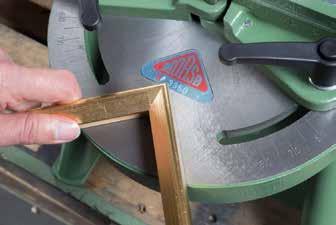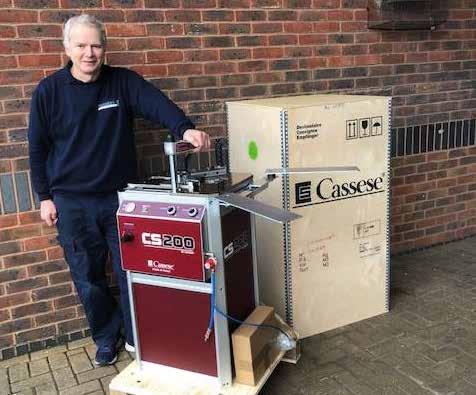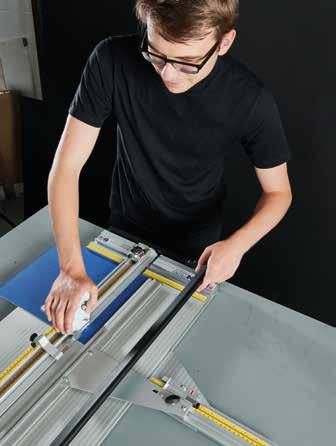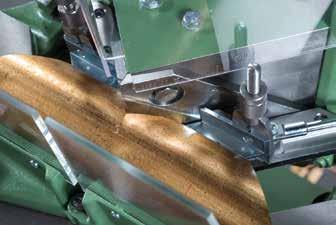
4 minute read
Focus on framing equipment
Every framer knows how important it is to get the right equipment, and it can be daunting trying to choose the correct machine from the vast array of products available. But fear not, we’ve spoken to Peter and Jan Stanlick from Framers Equipment, who have decades of experience in the framing equipment industry and are well-known experts.
Equipment is one of the most important purchases a framer makes and there is a lot to consider before coming to a conclusion on the right equipment for your business. Here, Peter has provided a handy list of things to think about before buying!
Advertisement
■ The nature of your business: The equipment required for bespoke framing will be entirely different to the equipment needed for production framing.
■ Location: The equipment you will need depends on whether your business is home-based, a shop, a gallery or an industrial unit.
■ Available workshop space: Space dictates which machines you are able to purchase and the services you are able to offer.
■ Material: The machines you purchase must work well with the materials you will be using.
■ Buy the best and most versatile equipment you can afford to save future expense. Peter added: “It is always worth considering in advance whether the machinery can meet your specific needs. Do you need to cut large profile mouldings, hardwoods, and or plastics, for example. Framers, photographers and graphic designers should consider a hot or cold laminator and a multi-material cutter for large format work.”
Increasingly now, a customer’s first port of call is the internet and other online selling platforms advertising used equipment. Unfortunately, the equipment often has missing parts, is damaged, or is no longer supported by the manufacturer – therefore beyond economical repair. Framers should be extremely careful and consider their time and money before purchasing or seek professional advice. In addition to selling equipment, Framers Equipment also runs accredited training courses covering a wide range of subjects including ‘Basic Training: Box Framing & Memorabilia’ and ‘Textiles: Conservation & Museum’ – and following the Fine Art Trade Guild Framing Standards.
Their next available training courses are the Basic Framing Course: 21st November and Textile Framing Course: 5th December. Both are available to book.
Framers Equipment was founded in 2000 by Peter and his father Tony Stanlick GCF. Peter’s brother Jan Stanlick GCF (APF) also joined the company early on – and continues to run the training side of the company as well as his own framing business Picture Hook in Norwich.
“It’s important that you get the best out of your machines,” Peter says, “and to avoid damaging your equipment, you must maintain it as per the manufacturer’s instructions on a regular basis. If you are not mechanically minded, you need to consider service training or an annual service visit to avoid machine breakdowns and loss of production. The simplest way to do this is to have the jobs listed in a diary to carry out on a regular basis.”
For more information go to www.framersequipment.co.uk
Here are Peter’s top six equipment recommendations:
1 Morso Mitre Guillotine, or Cassese Saw: either manual or automated, will allow you to achieve consistent quality mitre cuts.
2 Cassese Underpinner, manual or automated: the Cassese patented clamp system allows you to consistently create quality joints. This is easy to set up regardless of the profile of your moulding – it is particularly important for bespoke framers to use glue.
3 Mountcutter, manual or computerised: with the ability to cut regular and thick mountboard if you like to work creatively and follow fashionable trends. We recommend the Keencut Futura or
Fletcher mountcutters.
4 Wall Mounted Multi Material Cutter: this equipment will enable you to cut glass, acrylic, backing boards and mountboards, and will possibly save you more time and space than any other piece of equipment in the workshop! Again, we recommend the Fletcher or
Keencut material cutter.
5 Bambi or Hydrovane Compressor: air tools such as the compressor will speed up production and make your life considerably easier long term. For additional security, we would recommend allowing for extra air capacity to avoid additional expense at a later date.
6 Hot or Cold Roller Laminator: this machine gives you the ability to display large photographs, prints and posters – keeping them flat-mounted onto lightweight boards and can be covered with a protective film so that no glass is needed. This process is not reversible – so make sure you have the customer’s consent!


Taking delivery of another CS 200

The Keencut Futura











